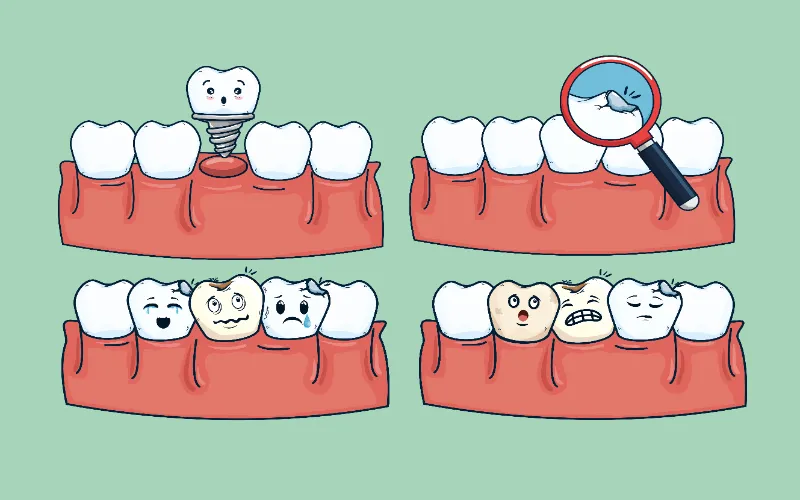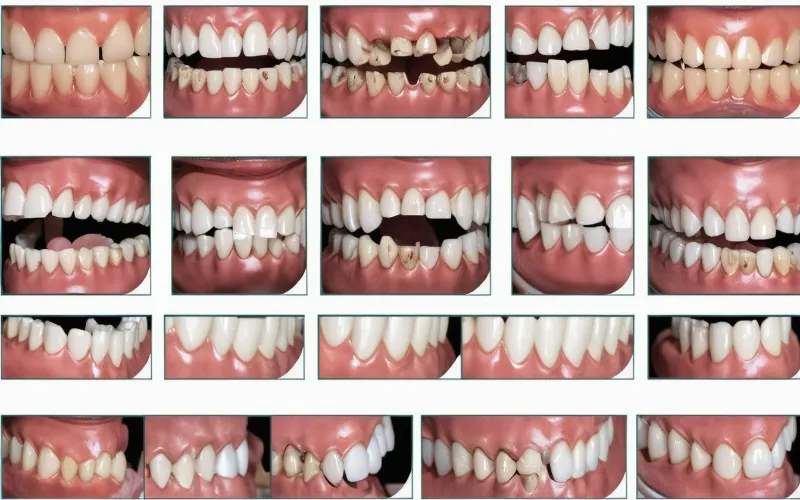Having a beautiful smile is not only aesthetically pleasing but also contributes to overall oral health. Crooked teeth, however, can be a source of insecurity and may have implications for your oral well-being. In this comprehensive guide, we’ll explore the causes of crooked teeth, the consequences they can have on your oral health and self-confidence, and the various treatment options available to help you fix them. Let’s dive in!
Definition and Causes of Crooked Teeth
Crooked teeth, also known as dental misalignment or malocclusion, refer to teeth that are not properly aligned within the dental arch. This misalignment can occur due to various factors, including genetic predisposition, improper dental development, overcrowding, or habits like thumb sucking or tongue thrusting.
Causes of Crooked Teeth
There are several underlying reasons why teeth may become crooked. Some of the most common causes include:
- Genetic Factors: Just like the color of your eyes or hair, the alignment of your teeth can be influenced by inherited traits. If your parents had crooked teeth, you may be more likely to experience the same difficulty.
- Jaw Size: A smaller jaw size can lead to overcrowding of teeth, which pushes the teeth together and causes them to become crooked.
- Poor Dental Habits: Habits developed in childhood, such as thumb sucking, using a pacifier for an extended period, or tongue thrusting, can exert pressure on the teeth and cause them to become misaligned.
- Dental Health Issues: Certain dental health problems like gum disease or tooth decay can also lead to teeth shifting out of place, resulting in crooked teeth.
- Premature Loss of Baby Teeth: If baby teeth fall out too early due to decay or injury, the remaining teeth may shift into the empty space, causing alignment issues when the permanent teeth start to come in.
- Injuries or Trauma: Trauma to the face or mouth can knock teeth out of place, leading to misalignment.
- Prolonged Bottle Feeding: Extended bottle feeding in early childhood can lead to the same problems associated with thumb sucking and pacifier use.
- Breathing through the Mouth: Chronic mouth breathing can change the shape of the face and jaw, leading to crooked teeth.
Common Types of Dental Misalignment
There are different types of dental misalignments that can contribute to crooked teeth, such as overcrowding, spacing issues, overbite, underbite, crossbite, and open bite. Each type requires specific treatment approaches, which we’ll explore later in this guide.
Exploring Different Types of Dental Misalignment
Let’s delve into each type of dental misalignment in more detail to understand how they contribute to crooked teeth
- Overcrowding: Overcrowding refers to a lack of sufficient space in the mouth to accommodate all teeth. This can lead to teeth growing in irregular positions, often overlapping each other, leading to a crowded appearance.
- Spacing Issues: Spacing issues occur when there’s too much room in the jaw, causing gaps and spaces between teeth. This can result from missing teeth, underdeveloped jaw, or smaller-than-average teeth size.
- Overbite: An overbite is a type of dental misalignment where the upper front teeth significantly overlap the lower front teeth when the mouth is closed. This can lead to excessive wear on the lower teeth.
- Underbite: An underbite, on the other hand, is characterized by the lower teeth protruding beyond the upper teeth when the mouth is closed. This can cause difficulties in chewing and lead to a ‘bulldog’ appearance.
- Crossbite: A crossbite occurs when some of the upper teeth sit inside the lower teeth rather than on the outside. This can lead to issues such as uneven wear, gum disease, and bone loss.
- Open Bite: An open bite is a type of dental misalignment where the upper and lower front teeth do not make contact when the mouth is closed, leaving an open gap. This can cause difficulties in biting and may lead to speech issues.
These are some common types of dental misalignments, each with its own set of challenges and treatment options. The next section will delve into the potential consequences of leaving these misalignments untreated.
Consequences of Crooked Teeth
While crooked teeth can affect your smile’s aesthetics, they can also lead to a number of oral health issues. Misaligned teeth can make it difficult to clean certain areas of your mouth properly, increasing the risk of tooth decay and gum disease.
Additionally, the abnormal stress placed on your teeth and jaw due to misalignment can lead to problems such as tooth wear, temporomandibular joint disorders, and even headaches.
Psychological Impacts
Aside from the physical implications, crooked teeth can also have psychological effects. People with misaligned teeth may feel self-conscious about their smile, leading to reduced self-esteem and reluctance to engage in social activities. Addressing these alignment issues can contribute significantly to an individual’s mental well-being and overall quality of life.
Stay tuned as we dive deeper into the different treatment options available to fix crooked teeth in the next sections.
Oral Health Implications
Crooked teeth can have a significant impact on your oral health. Misaligned teeth can make it challenging to properly clean between teeth, leading to a higher risk of tooth decay, gum disease, and bad breath. Additionally, the pressure exerted on unevenly aligned teeth can cause undue wear and tear, leading to potential tooth fractures or temporomandibular joint (TMJ) disorders.
Aesthetic Concerns and Impact on Self-Confidence
Beyond the oral health implications, crooked teeth can also take a toll on your self-confidence. When you feel self-conscious about your smile, it may affect your personal and professional relationships, as well as your overall well-being. Addressing crooked teeth can boost your confidence and provide you with a beautiful, radiant smile.
Treatment Options
There are several treatment options available to correct crooked teeth, including braces, Invisalign, retainers, and in some cases, dental surgery.
Orthodontic Treatments
Orthodontic treatments are the most common and effective approach to fix crooked teeth. They involve using various techniques to gradually move teeth into their desired positions. The two primary options are traditional braces and clear aligners.
Traditional Braces
Traditional braces consist of metal or ceramic brackets bonded to the teeth. Wires and elastics are then used to apply controlled pressure, gradually shifting the teeth into alignment. While they may be more noticeable, traditional braces are highly effective in treating complex dental misalignments.
Clear Aligners
Clear aligners, such as Invisalign, are a discreet alternative to traditional braces. They are custom-made, transparent aligners that fit over your teeth and gently guide them into the desired positions. Clear aligners offer the advantage of being removable, allowing for easier oral hygiene maintenance and the freedom to eat and drink without restrictions.
Dental Veneers and Crowns
In some cases, crooked teeth may be due to aesthetic concerns rather than severe misalignment. Dental veneers and crowns can be viable options to enhance the appearance of crooked teeth.
- Dental Veneers: Dental veneers are thin, custom-made shells that are bonded to the front surface of your teeth. They can effectively mask minor misalignments, providing you with a straighter and more symmetrical smile. Veneers are typically made from porcelain or composite resin and offer a long-lasting solution for improving the aesthetics of crooked teeth.
- Dental Crowns: Dental crowns, also known as caps, are tooth-shaped restorations that cover the entire visible portion of a tooth. They can be used to correct the appearance of severely crooked teeth, providing both cosmetic and functional benefits. Dental crowns are custom-made to match the color, shape, and size of your natural teeth, ensuring a seamless and natural-looking result.
Conclusion
Crooked teeth are not just a cosmetic concern; they can significantly affect oral health and self-confidence. Fortunately, there are various treatment options available to help you achieve a straighter and more beautiful smile. Whether you choose orthodontic treatments like braces or clear aligners, or opt for dental veneers and crowns, consulting with a qualified dentist or orthodontist will guide you towards the best solution for your specific needs. Don’t let crooked teeth hold you back from showcasing your radiant smile. Take the first step towards a confident and healthier future by exploring the treatment options available to fix crooked teeth.

Dr. Orion Johnson is a dedicated and compassionate dentist committed to providing exceptional dental care to his patients.Dr. Johnson obtained his Doctor of Dental Surgery (DDS) degree from a prestigious dental school, where he excelled academically and clinically. He is licensed to practice dentistry and stays updated with the technology through continuing education and training.

